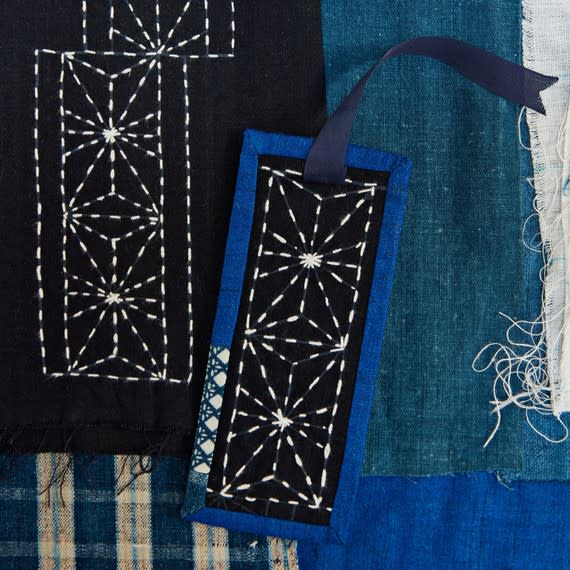Sashiko: The Japanese Art of Mending Fabric with Beautiful Stitches

In the times of pre-industrial Japan, fabric was scarce and so garments were mended for a longer life with patches, scraps, and simple stitches. A single garment could be mended many times over many generations, developing a storied history.
This is sashiko, and this type of mending was never meant to be invisible. Rather, it's meant to highlight the rips, tears, frays, and fringes of an individual garment with stitches in a contrasting thread. Sashiko translated means "little stabs," which perfectly describes the distinctive running stitch that defines the technique's style. In sashiko, it's the contours of the damage that dictate the repair and reinvent the garment into something better than before—a stronger fabric, a more beautified design.
Common motifs were originally inspired by natural surroundings—ocean waves, mountain peaks, and fields of grass—resulting in concentric circles and geometric patterns with poetic names such as persimmon flower (kaki no hana) or pine bark (matsukawabishi).
Today, the traditional Japanese art of sashiko has found new life in the era of slow fashion and visible mending. Whether you're hand-quilting a blanket, repairing your best pair of jeans, or personalizing a pocket or patchwork throw, sashiko blends function and fashion.
Tour the Tatter Textile Library, a Crafter's Paradise

Tools and Materials
A handful of simple necessities are needed for this specialty technique. Once they're added to your sewing kit, they will make your mending all the more seamless. If you're a beginner, it's a good idea to practice by following a template or pattern.
Sashiko needle
The sashiko needle is long, sturdy, and specially made for running stitches. In other words, it is designed to let you load multiple stitches onto it before pulling it through the fabric. They come in a range of sizes; traditional ones measure about 2 inches while modern ones tend to be shorter and have a larger eye for easier threading.
SHOP NOW: Olympus sashiko needles, $2 for set of 2, fancytigercrafts.com.
SHOP NOW: Tulip sashiko needle, $9.50 for set of 2, stonemountainfabric.com.
Sashiko thread
Sashiko thread is made of sturdy, heavy-weight cotton, and usually available in 20-meter skeins. Embroidery floss can be a suitable substitute—the difference being its sheen quality and the looser strands that can be singled out for thinner stitches; as such, the look and feel of the stitching will be slightly different. The most common substitute is pearl cotton in size 8 or 12. Today, it comes in a variety of colors although white is still the traditional choice as it pairs beautifully with indigo cloth.
SHOP NOW: Olympus sashiko thread, $2 for 22 yds., brooklyngeneral.com.
Cotton indigo fabric
Sashiko works best on a linen or cotton blend with a loose weave. Because sashiko thread is thick, a fabric that is too tightly woven will show puckering more easily. While sashiko mending has origins in cotton fabric, you may also try denim. Denim is a great choice for visible mending because it's heavy, durable, and truly utilitarian. As with thread, match the fabric patch to the fiber you're mending. The idea is to create contrast on the garment.
SHOP NOW: Olympus sashiko samplers, starting at $9.60, purlsoho.com.
Sashiko thimble
As with all hand sewing, a thimble is your best safeguard. A sashiko thimble is worn much like a ring at the base of your middle finger on your dominant hand. To use it in stitching, load the needle then place the eye-end against the thimble's protective pad to push it through the fabric. They come in various sizes, so be sure to choose one that fits your finger. Metal thimbles offer the ultimate durability. Alternatively, leather is more supple and allows the skin to breathe while working for longer periods of time.
SHOP NOW: Leather sashiko thimble, $3.50, tadaastudio.com.
SHOP NOW: Clover sashiko ring thimble with plate #611, $4, shiboridragon.com.
Extra tools
Supplement your sashiko with these supplements: scissors (for snipping patches, trimming thread, and cutting fabric), straight pins (for securing those patches to a garment), tailor's chalk (for drawing straight lines for stitches or outlining the edges of a patch), and a ruler (for measuring and making straight lines).
Learn All About Essential Craft Tools
How Is It Used?
Sashiko relies on the running stitch, which is made by inserting the needle through the fabric—loading several stitches onto the needle at once—before pulling it through. This maximizes the length of your needle and results in a line of straight evenly-spaced stitches. However, this can be used to stitch the outline of a circle, square, triangle or any other shape.
Garments are composed of fibers, and these fibers naturally wear and tear over time. So always consider the weave and weight of the fabric you're mending. For instance, denim is slow to fray and if you keep your stitches about 1/2 inch from the edge of the patch, the edges shouldn't fray through the mending stitches. Alternately, linen frays easily and may require closer stitches for a finished edge.
Get Our Pattern for a Sashiko Bookmark
Remember, it's alright if the stitches aren't perfect. Each mended piece has the signature of its maker, and the homespun quality only adds to its charm. When we spend time patching, stitching, darning, or otherwise fixing torn fabrics, we ultimately deepen our understanding of its craftsmanship. Sashiko forces us to slow down, be intentional, and remember the ingenuity that can be realized when you wield a simple needle and thread. Remember, above all, the ethos of sashiko: your personal touch adds to the beauty of a well-aged garment.
Feeling inspired? Watch how to make your own sewing kit in a jar: